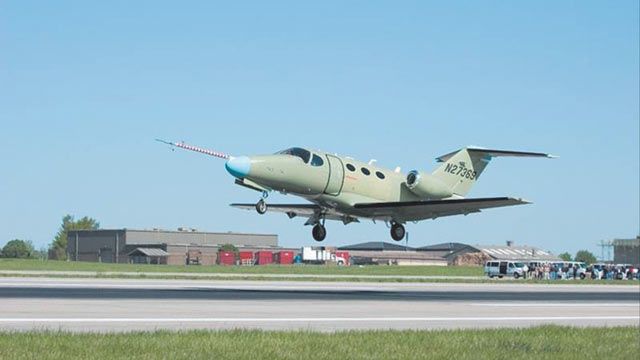Cessna Enhances Antiskid Technology with Hardware-in-the-Loop Testing
"We created a hardware-in-the-loop testing tool using Simulink, Simulink Coder, and Simulink Real-Time that enables us to very rapidly test control algorithms in a way that is simply not possible on an actual airplane."
Challenge
Solution
Results
- Thousands of dollars and months of time saved
- Ramp-up time minimized
- Intermittent control problem isolated

Citation jets from the Cessna Aircraft Company are known for their innovative technology and passenger comfort. When test pilots reported an issue with the aircraft's antiskid brake control system, Cessna engineers jumped at the chance to improve the product. The issue was intermittent, however, making it difficult to isolate and replicate.
Cessna engineers identified and addressed the issue by using MathWorks tools to develop a software model of the aircraft and run real-time hardware-in-the-loop (HIL) tests that simulated system behavior under a variety of conditions.
"HIL testing using MathWorks tools enabled us to quickly detect root causes and study improvements for future antiskid systems without using valuable flight time on actual aircraft," says Alan Johnson, lead engineer at Cessna.
Challenge
While the aircraft continued to meet its certification requirements, on some landings the prototype's brake control system applied and released the brakes more than necessary. Because the problem happened rarely, it was difficult to isolate. Cessna knew that certain combinations of runway and brake wear conditions played a role, but conducting hundreds of flights and landings while emulating these conditions would have been expensive and time-consuming.
The company needed to simulate the aircraft landing in a variety of conditions while examining the real-time operation of the control system. They considered purchasing a third-party aircraft simulation system, but cost and time constraints made that approach impractical.
"There are proprietary simulation systems available for a few hundred thousand dollars, and they typically have a two- or three-month lead time to get the system," notes Johnson. "We didn’t have that much in our budget, and we needed to be done, not just getting started, in two or three months."
Solution
Cessna rapidly developed HIL tests for the prototype’s brake control system using Simulink®, Simulink Coder™, and Simulink Real-Time™.
Two Cessna engineers developed a model of the prototype in Simulink. The model incorporated lift, drag, engine thrust, and the trailing link main landing gear. It also included parameters to simulate runway conditions—including water, snow, or ice on asphalt and grooved runways—as well as different brake wear conditions. The engineers then used Simulink Coder to automatically generate ANSI C code from the Simulink model.
With Simulink Real-Time they ran the code and executed the model in real time on commercial off-the-shelf hardware connected to the aircraft’s brake control system.
Using this testing environment, the engineers simulated hundreds of landings under different conditions until they could replicate the symptom consistently. During simulations, the team gathered data on 20 different parameters at a sample rate of 2000 Hz. With each real-time test lasting more than 20 seconds, more than a gigabyte of data was produced for each run.
Cessna used MATLAB® to analyze the test data, plot various signal relationships, and ultimately, to identify the cause of the brake control issue: a dead band in the brake controller.
After finding the dead band, the team developed a design that addressed the issue using additional parameters available from the aircraft controls and systems, and both the test pilots and the engineers were pleased with the new performance. Being able to find intermittent issues quickly and cheaply gives Cessna a competitive edge in a market that demands perfection.
Since this prototype antiskid project, Cessna has expanded its use of HIL testing, and now uses MathWorks tools to test all new brake control systems.
Results
Thousands of dollars and months of time saved. "If we had to instrument an aircraft and conduct the hundreds of landings we needed, it would have cost thousands of dollars and taken three or four times as long," says Johnson. "With MathWorks tools we could run four simulations in 15 minutes, and it cost us nothing. Four landings in a real jet would take an hour and cost between $5,000 and $10,000."
Ramp-up time minimized. "With MathWorks tools, two engineers working part time and starting from scratch assembled the entire HIL project in three months—about the same time it would have taken us just to acquire a proprietary aircraft simulation system," says Johnson. "Our model ran on Simulink Real-Time the very first time we turned it on. MathWorks tools are so easy to work with, it was like plug and play."
Intermittent control problem isolated. "An intermittent problem is really tough to track down," says Johnson. "By using MathWorks tools in the lab we kept simulating landings, with precisely controlled conditions, until we found it—and then we could replicate it every time. We would do a run, download the data from Simulink Real-Time, plot it out, and in two minutes be running the next simulation."